Critical Role of Nursing Leadership
VerifiedAdded on 2020/11/12
|11
|3666
|119
AI Summary
This report emphasizes the significance of nursing leadership and management in healthcare. It discusses the importance of possessing key leadership skills, such as relational leadership, to provide high-quality care to patients. The assignment also touches on inter-professional collaboration, highlighting its potential benefits and challenges, including increased workload for professionals. Nursing leaders play a crucial role in delivering good treatment and care to patients, and their views on inter-professional and multi-agency working are critical. The report concludes that effective nursing leadership is essential for patient satisfaction and organizational success.
Contribute Materials
Your contribution can guide someone’s learning journey. Share your
documents today.
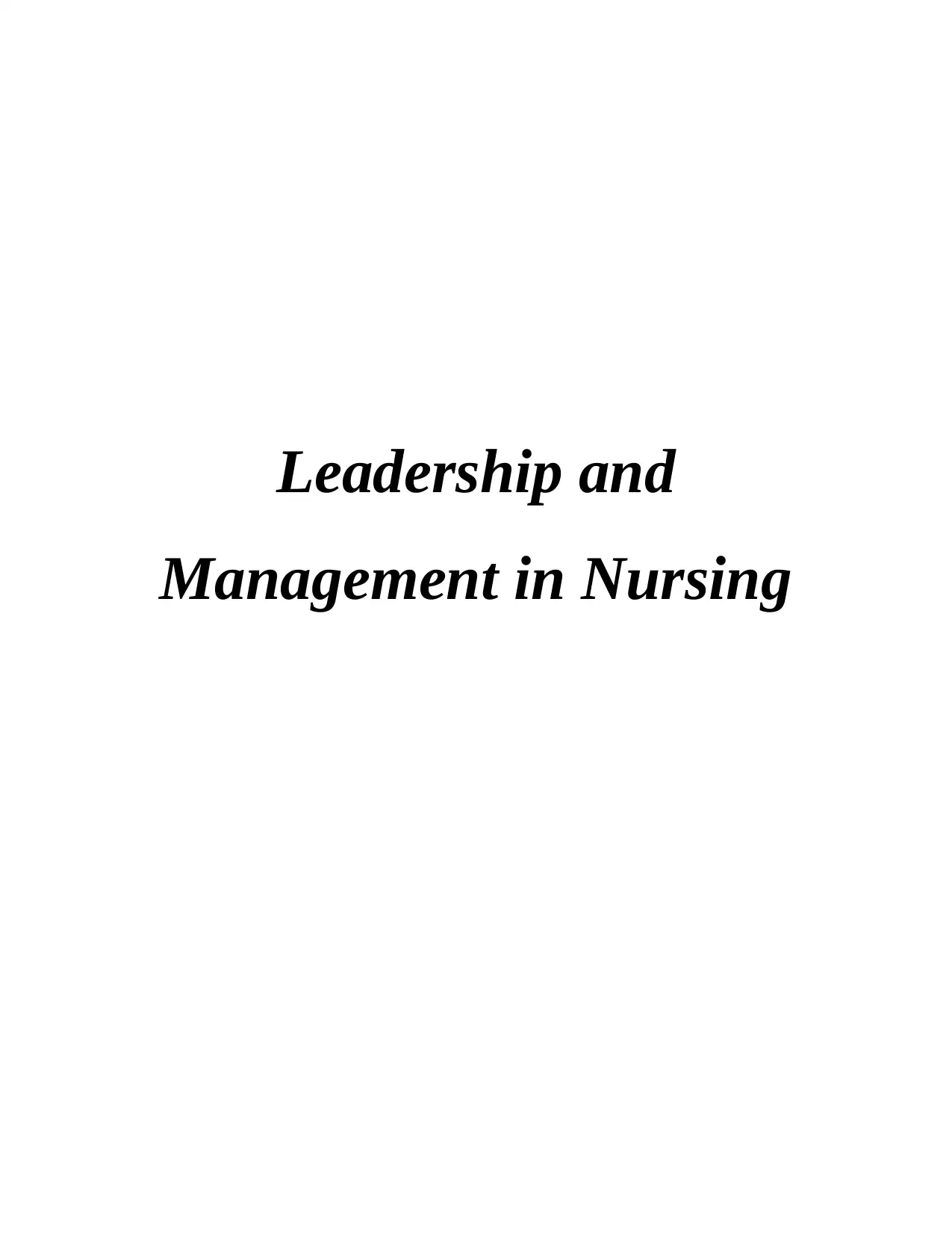
Leadership and
Management in Nursing
Management in Nursing
Secure Best Marks with AI Grader
Need help grading? Try our AI Grader for instant feedback on your assignments.
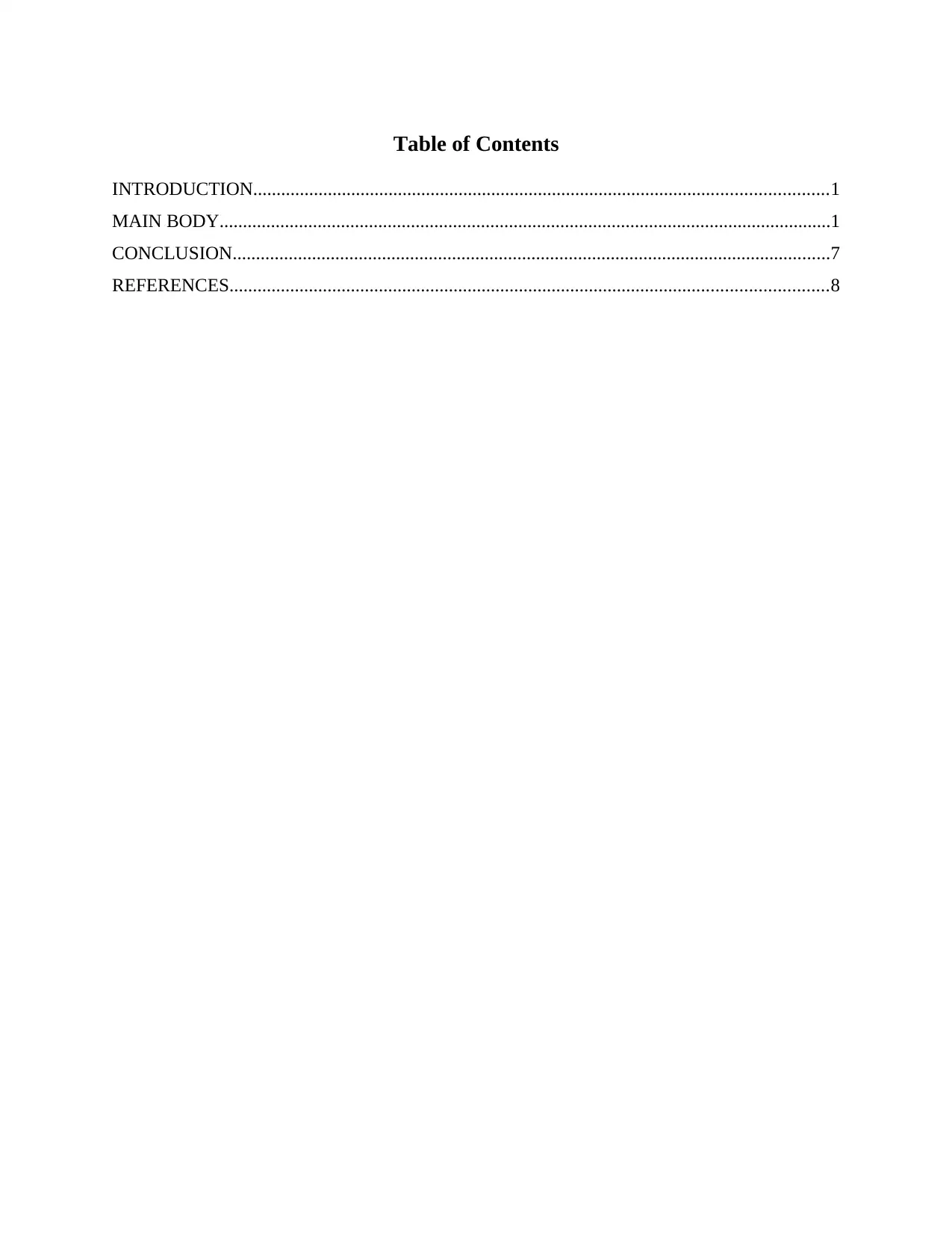
Table of Contents
INTRODUCTION...........................................................................................................................1
MAIN BODY...................................................................................................................................1
CONCLUSION................................................................................................................................7
REFERENCES................................................................................................................................8
INTRODUCTION...........................................................................................................................1
MAIN BODY...................................................................................................................................1
CONCLUSION................................................................................................................................7
REFERENCES................................................................................................................................8
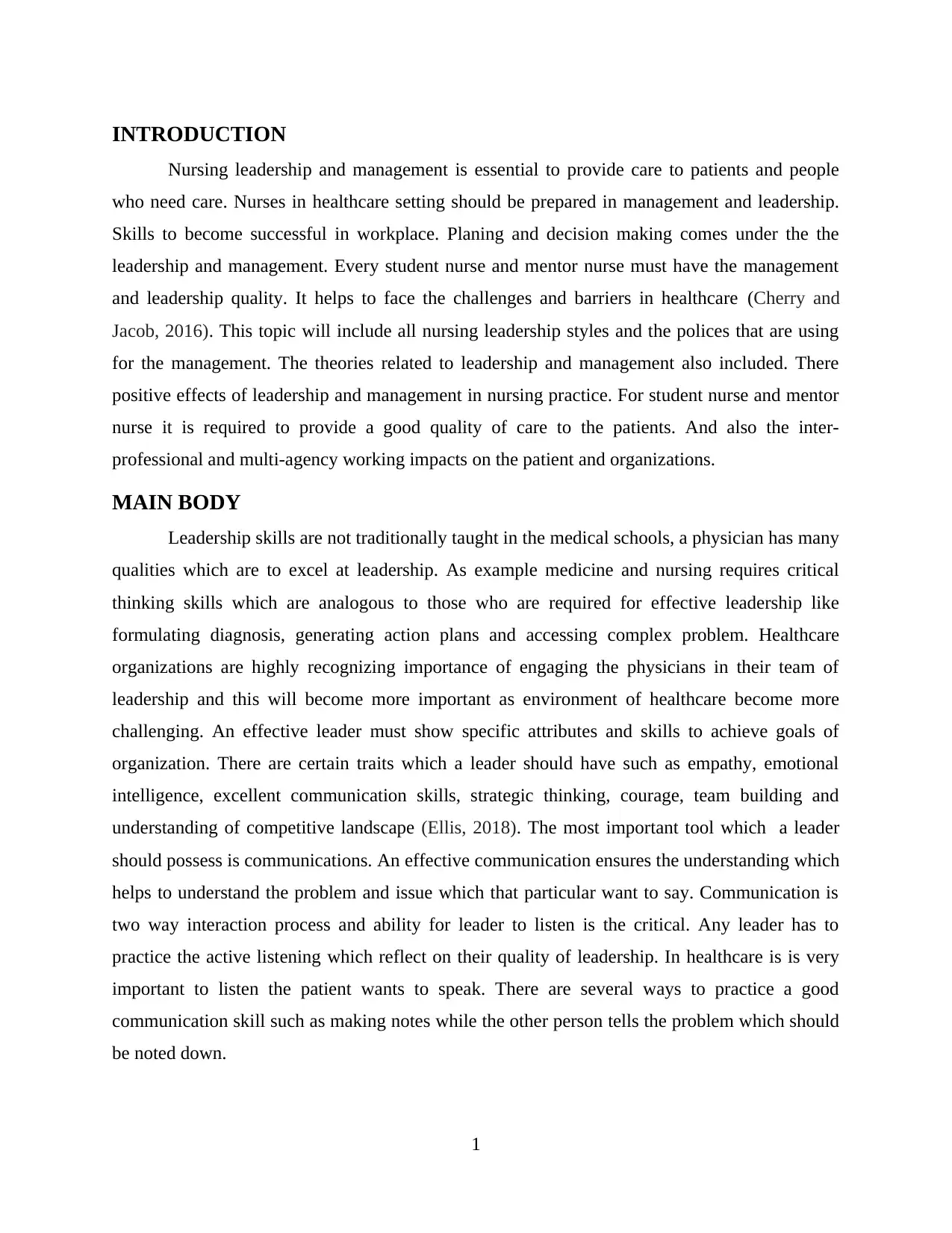
INTRODUCTION
Nursing leadership and management is essential to provide care to patients and people
who need care. Nurses in healthcare setting should be prepared in management and leadership.
Skills to become successful in workplace. Planing and decision making comes under the the
leadership and management. Every student nurse and mentor nurse must have the management
and leadership quality. It helps to face the challenges and barriers in healthcare (Cherry and
Jacob, 2016). This topic will include all nursing leadership styles and the polices that are using
for the management. The theories related to leadership and management also included. There
positive effects of leadership and management in nursing practice. For student nurse and mentor
nurse it is required to provide a good quality of care to the patients. And also the inter-
professional and multi-agency working impacts on the patient and organizations.
MAIN BODY
Leadership skills are not traditionally taught in the medical schools, a physician has many
qualities which are to excel at leadership. As example medicine and nursing requires critical
thinking skills which are analogous to those who are required for effective leadership like
formulating diagnosis, generating action plans and accessing complex problem. Healthcare
organizations are highly recognizing importance of engaging the physicians in their team of
leadership and this will become more important as environment of healthcare become more
challenging. An effective leader must show specific attributes and skills to achieve goals of
organization. There are certain traits which a leader should have such as empathy, emotional
intelligence, excellent communication skills, strategic thinking, courage, team building and
understanding of competitive landscape (Ellis, 2018). The most important tool which a leader
should possess is communications. An effective communication ensures the understanding which
helps to understand the problem and issue which that particular want to say. Communication is
two way interaction process and ability for leader to listen is the critical. Any leader has to
practice the active listening which reflect on their quality of leadership. In healthcare is is very
important to listen the patient wants to speak. There are several ways to practice a good
communication skill such as making notes while the other person tells the problem which should
be noted down.
1
Nursing leadership and management is essential to provide care to patients and people
who need care. Nurses in healthcare setting should be prepared in management and leadership.
Skills to become successful in workplace. Planing and decision making comes under the the
leadership and management. Every student nurse and mentor nurse must have the management
and leadership quality. It helps to face the challenges and barriers in healthcare (Cherry and
Jacob, 2016). This topic will include all nursing leadership styles and the polices that are using
for the management. The theories related to leadership and management also included. There
positive effects of leadership and management in nursing practice. For student nurse and mentor
nurse it is required to provide a good quality of care to the patients. And also the inter-
professional and multi-agency working impacts on the patient and organizations.
MAIN BODY
Leadership skills are not traditionally taught in the medical schools, a physician has many
qualities which are to excel at leadership. As example medicine and nursing requires critical
thinking skills which are analogous to those who are required for effective leadership like
formulating diagnosis, generating action plans and accessing complex problem. Healthcare
organizations are highly recognizing importance of engaging the physicians in their team of
leadership and this will become more important as environment of healthcare become more
challenging. An effective leader must show specific attributes and skills to achieve goals of
organization. There are certain traits which a leader should have such as empathy, emotional
intelligence, excellent communication skills, strategic thinking, courage, team building and
understanding of competitive landscape (Ellis, 2018). The most important tool which a leader
should possess is communications. An effective communication ensures the understanding which
helps to understand the problem and issue which that particular want to say. Communication is
two way interaction process and ability for leader to listen is the critical. Any leader has to
practice the active listening which reflect on their quality of leadership. In healthcare is is very
important to listen the patient wants to speak. There are several ways to practice a good
communication skill such as making notes while the other person tells the problem which should
be noted down.
1
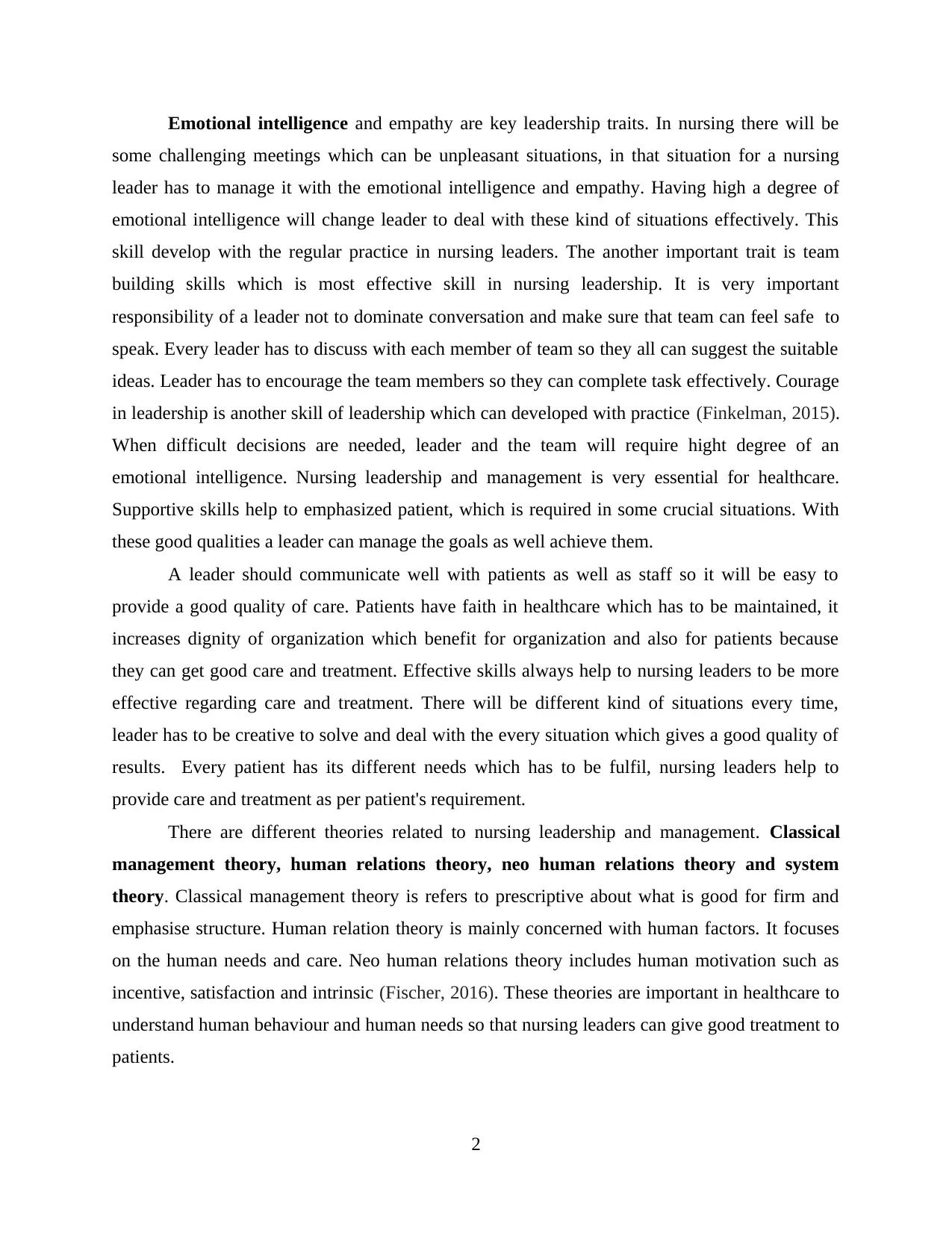
Emotional intelligence and empathy are key leadership traits. In nursing there will be
some challenging meetings which can be unpleasant situations, in that situation for a nursing
leader has to manage it with the emotional intelligence and empathy. Having high a degree of
emotional intelligence will change leader to deal with these kind of situations effectively. This
skill develop with the regular practice in nursing leaders. The another important trait is team
building skills which is most effective skill in nursing leadership. It is very important
responsibility of a leader not to dominate conversation and make sure that team can feel safe to
speak. Every leader has to discuss with each member of team so they all can suggest the suitable
ideas. Leader has to encourage the team members so they can complete task effectively. Courage
in leadership is another skill of leadership which can developed with practice (Finkelman, 2015).
When difficult decisions are needed, leader and the team will require hight degree of an
emotional intelligence. Nursing leadership and management is very essential for healthcare.
Supportive skills help to emphasized patient, which is required in some crucial situations. With
these good qualities a leader can manage the goals as well achieve them.
A leader should communicate well with patients as well as staff so it will be easy to
provide a good quality of care. Patients have faith in healthcare which has to be maintained, it
increases dignity of organization which benefit for organization and also for patients because
they can get good care and treatment. Effective skills always help to nursing leaders to be more
effective regarding care and treatment. There will be different kind of situations every time,
leader has to be creative to solve and deal with the every situation which gives a good quality of
results. Every patient has its different needs which has to be fulfil, nursing leaders help to
provide care and treatment as per patient's requirement.
There are different theories related to nursing leadership and management. Classical
management theory, human relations theory, neo human relations theory and system
theory. Classical management theory is refers to prescriptive about what is good for firm and
emphasise structure. Human relation theory is mainly concerned with human factors. It focuses
on the human needs and care. Neo human relations theory includes human motivation such as
incentive, satisfaction and intrinsic (Fischer, 2016). These theories are important in healthcare to
understand human behaviour and human needs so that nursing leaders can give good treatment to
patients.
2
some challenging meetings which can be unpleasant situations, in that situation for a nursing
leader has to manage it with the emotional intelligence and empathy. Having high a degree of
emotional intelligence will change leader to deal with these kind of situations effectively. This
skill develop with the regular practice in nursing leaders. The another important trait is team
building skills which is most effective skill in nursing leadership. It is very important
responsibility of a leader not to dominate conversation and make sure that team can feel safe to
speak. Every leader has to discuss with each member of team so they all can suggest the suitable
ideas. Leader has to encourage the team members so they can complete task effectively. Courage
in leadership is another skill of leadership which can developed with practice (Finkelman, 2015).
When difficult decisions are needed, leader and the team will require hight degree of an
emotional intelligence. Nursing leadership and management is very essential for healthcare.
Supportive skills help to emphasized patient, which is required in some crucial situations. With
these good qualities a leader can manage the goals as well achieve them.
A leader should communicate well with patients as well as staff so it will be easy to
provide a good quality of care. Patients have faith in healthcare which has to be maintained, it
increases dignity of organization which benefit for organization and also for patients because
they can get good care and treatment. Effective skills always help to nursing leaders to be more
effective regarding care and treatment. There will be different kind of situations every time,
leader has to be creative to solve and deal with the every situation which gives a good quality of
results. Every patient has its different needs which has to be fulfil, nursing leaders help to
provide care and treatment as per patient's requirement.
There are different theories related to nursing leadership and management. Classical
management theory, human relations theory, neo human relations theory and system
theory. Classical management theory is refers to prescriptive about what is good for firm and
emphasise structure. Human relation theory is mainly concerned with human factors. It focuses
on the human needs and care. Neo human relations theory includes human motivation such as
incentive, satisfaction and intrinsic (Fischer, 2016). These theories are important in healthcare to
understand human behaviour and human needs so that nursing leaders can give good treatment to
patients.
2
Secure Best Marks with AI Grader
Need help grading? Try our AI Grader for instant feedback on your assignments.
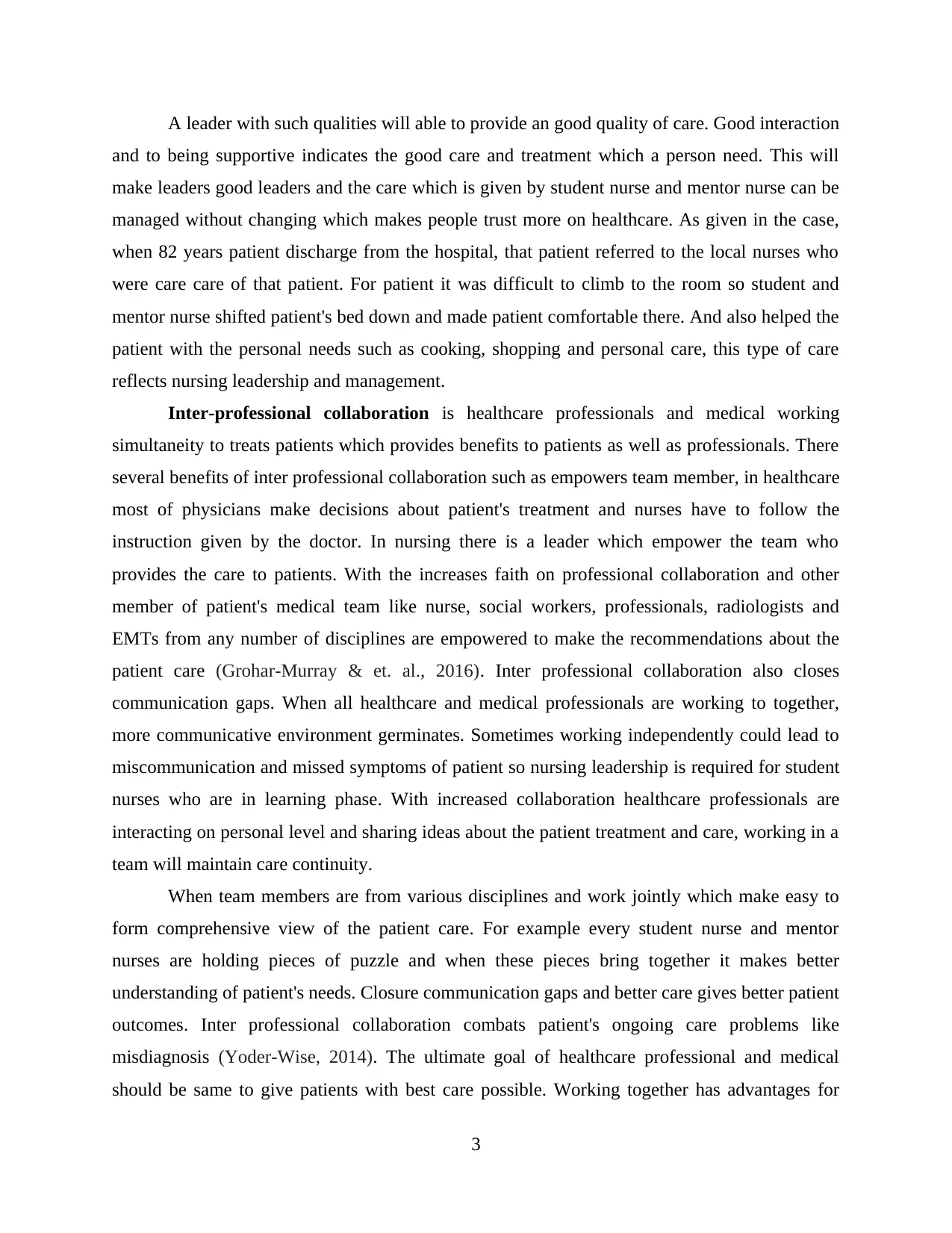
A leader with such qualities will able to provide an good quality of care. Good interaction
and to being supportive indicates the good care and treatment which a person need. This will
make leaders good leaders and the care which is given by student nurse and mentor nurse can be
managed without changing which makes people trust more on healthcare. As given in the case,
when 82 years patient discharge from the hospital, that patient referred to the local nurses who
were care care of that patient. For patient it was difficult to climb to the room so student and
mentor nurse shifted patient's bed down and made patient comfortable there. And also helped the
patient with the personal needs such as cooking, shopping and personal care, this type of care
reflects nursing leadership and management.
Inter-professional collaboration is healthcare professionals and medical working
simultaneity to treats patients which provides benefits to patients as well as professionals. There
several benefits of inter professional collaboration such as empowers team member, in healthcare
most of physicians make decisions about patient's treatment and nurses have to follow the
instruction given by the doctor. In nursing there is a leader which empower the team who
provides the care to patients. With the increases faith on professional collaboration and other
member of patient's medical team like nurse, social workers, professionals, radiologists and
EMTs from any number of disciplines are empowered to make the recommendations about the
patient care (Grohar-Murray & et. al., 2016). Inter professional collaboration also closes
communication gaps. When all healthcare and medical professionals are working to together,
more communicative environment germinates. Sometimes working independently could lead to
miscommunication and missed symptoms of patient so nursing leadership is required for student
nurses who are in learning phase. With increased collaboration healthcare professionals are
interacting on personal level and sharing ideas about the patient treatment and care, working in a
team will maintain care continuity.
When team members are from various disciplines and work jointly which make easy to
form comprehensive view of the patient care. For example every student nurse and mentor
nurses are holding pieces of puzzle and when these pieces bring together it makes better
understanding of patient's needs. Closure communication gaps and better care gives better patient
outcomes. Inter professional collaboration combats patient's ongoing care problems like
misdiagnosis (Yoder-Wise, 2014). The ultimate goal of healthcare professional and medical
should be same to give patients with best care possible. Working together has advantages for
3
and to being supportive indicates the good care and treatment which a person need. This will
make leaders good leaders and the care which is given by student nurse and mentor nurse can be
managed without changing which makes people trust more on healthcare. As given in the case,
when 82 years patient discharge from the hospital, that patient referred to the local nurses who
were care care of that patient. For patient it was difficult to climb to the room so student and
mentor nurse shifted patient's bed down and made patient comfortable there. And also helped the
patient with the personal needs such as cooking, shopping and personal care, this type of care
reflects nursing leadership and management.
Inter-professional collaboration is healthcare professionals and medical working
simultaneity to treats patients which provides benefits to patients as well as professionals. There
several benefits of inter professional collaboration such as empowers team member, in healthcare
most of physicians make decisions about patient's treatment and nurses have to follow the
instruction given by the doctor. In nursing there is a leader which empower the team who
provides the care to patients. With the increases faith on professional collaboration and other
member of patient's medical team like nurse, social workers, professionals, radiologists and
EMTs from any number of disciplines are empowered to make the recommendations about the
patient care (Grohar-Murray & et. al., 2016). Inter professional collaboration also closes
communication gaps. When all healthcare and medical professionals are working to together,
more communicative environment germinates. Sometimes working independently could lead to
miscommunication and missed symptoms of patient so nursing leadership is required for student
nurses who are in learning phase. With increased collaboration healthcare professionals are
interacting on personal level and sharing ideas about the patient treatment and care, working in a
team will maintain care continuity.
When team members are from various disciplines and work jointly which make easy to
form comprehensive view of the patient care. For example every student nurse and mentor
nurses are holding pieces of puzzle and when these pieces bring together it makes better
understanding of patient's needs. Closure communication gaps and better care gives better patient
outcomes. Inter professional collaboration combats patient's ongoing care problems like
misdiagnosis (Yoder-Wise, 2014). The ultimate goal of healthcare professional and medical
should be same to give patients with best care possible. Working together has advantages for
3
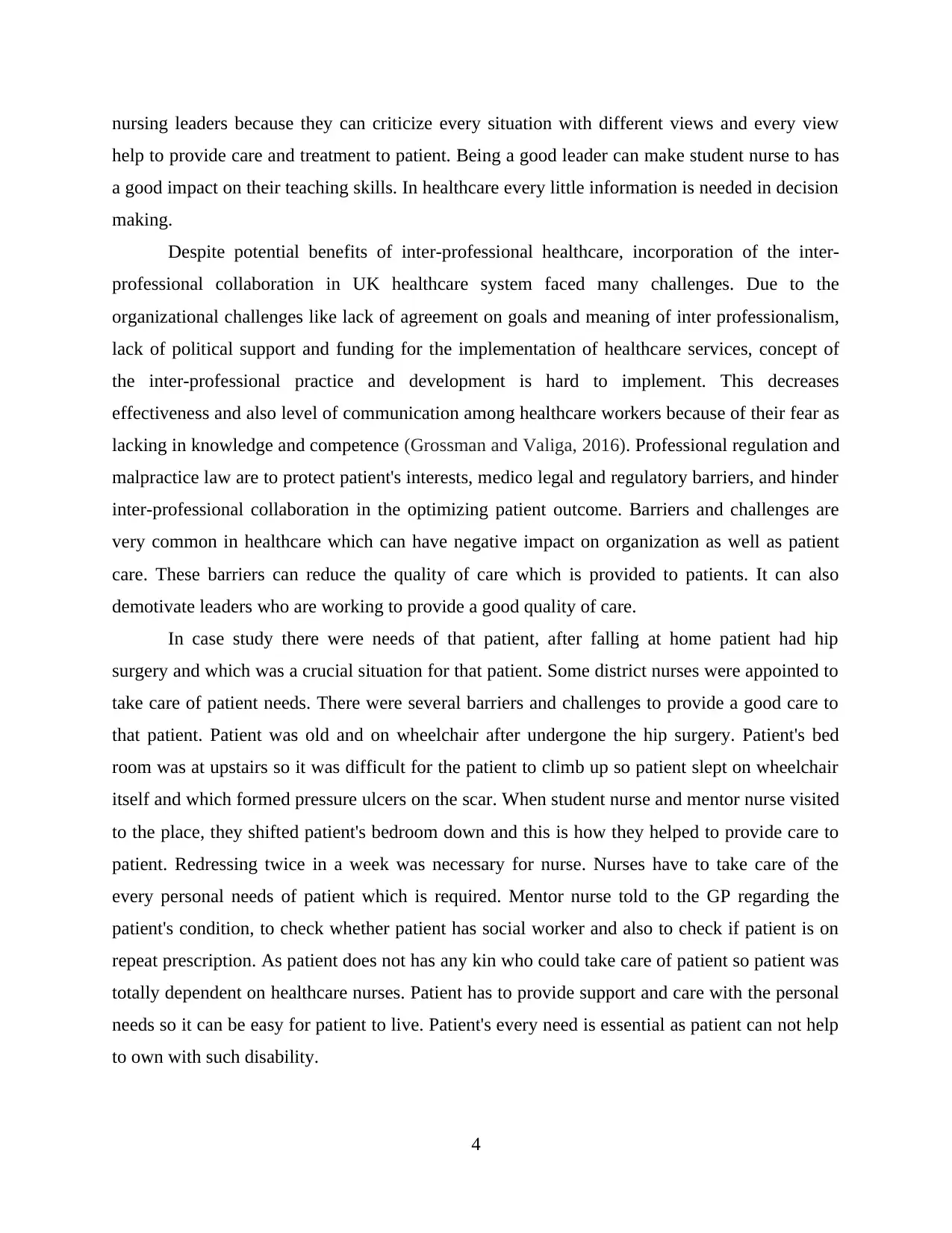
nursing leaders because they can criticize every situation with different views and every view
help to provide care and treatment to patient. Being a good leader can make student nurse to has
a good impact on their teaching skills. In healthcare every little information is needed in decision
making.
Despite potential benefits of inter-professional healthcare, incorporation of the inter-
professional collaboration in UK healthcare system faced many challenges. Due to the
organizational challenges like lack of agreement on goals and meaning of inter professionalism,
lack of political support and funding for the implementation of healthcare services, concept of
the inter-professional practice and development is hard to implement. This decreases
effectiveness and also level of communication among healthcare workers because of their fear as
lacking in knowledge and competence (Grossman and Valiga, 2016). Professional regulation and
malpractice law are to protect patient's interests, medico legal and regulatory barriers, and hinder
inter-professional collaboration in the optimizing patient outcome. Barriers and challenges are
very common in healthcare which can have negative impact on organization as well as patient
care. These barriers can reduce the quality of care which is provided to patients. It can also
demotivate leaders who are working to provide a good quality of care.
In case study there were needs of that patient, after falling at home patient had hip
surgery and which was a crucial situation for that patient. Some district nurses were appointed to
take care of patient needs. There were several barriers and challenges to provide a good care to
that patient. Patient was old and on wheelchair after undergone the hip surgery. Patient's bed
room was at upstairs so it was difficult for the patient to climb up so patient slept on wheelchair
itself and which formed pressure ulcers on the scar. When student nurse and mentor nurse visited
to the place, they shifted patient's bedroom down and this is how they helped to provide care to
patient. Redressing twice in a week was necessary for nurse. Nurses have to take care of the
every personal needs of patient which is required. Mentor nurse told to the GP regarding the
patient's condition, to check whether patient has social worker and also to check if patient is on
repeat prescription. As patient does not has any kin who could take care of patient so patient was
totally dependent on healthcare nurses. Patient has to provide support and care with the personal
needs so it can be easy for patient to live. Patient's every need is essential as patient can not help
to own with such disability.
4
help to provide care and treatment to patient. Being a good leader can make student nurse to has
a good impact on their teaching skills. In healthcare every little information is needed in decision
making.
Despite potential benefits of inter-professional healthcare, incorporation of the inter-
professional collaboration in UK healthcare system faced many challenges. Due to the
organizational challenges like lack of agreement on goals and meaning of inter professionalism,
lack of political support and funding for the implementation of healthcare services, concept of
the inter-professional practice and development is hard to implement. This decreases
effectiveness and also level of communication among healthcare workers because of their fear as
lacking in knowledge and competence (Grossman and Valiga, 2016). Professional regulation and
malpractice law are to protect patient's interests, medico legal and regulatory barriers, and hinder
inter-professional collaboration in the optimizing patient outcome. Barriers and challenges are
very common in healthcare which can have negative impact on organization as well as patient
care. These barriers can reduce the quality of care which is provided to patients. It can also
demotivate leaders who are working to provide a good quality of care.
In case study there were needs of that patient, after falling at home patient had hip
surgery and which was a crucial situation for that patient. Some district nurses were appointed to
take care of patient needs. There were several barriers and challenges to provide a good care to
that patient. Patient was old and on wheelchair after undergone the hip surgery. Patient's bed
room was at upstairs so it was difficult for the patient to climb up so patient slept on wheelchair
itself and which formed pressure ulcers on the scar. When student nurse and mentor nurse visited
to the place, they shifted patient's bedroom down and this is how they helped to provide care to
patient. Redressing twice in a week was necessary for nurse. Nurses have to take care of the
every personal needs of patient which is required. Mentor nurse told to the GP regarding the
patient's condition, to check whether patient has social worker and also to check if patient is on
repeat prescription. As patient does not has any kin who could take care of patient so patient was
totally dependent on healthcare nurses. Patient has to provide support and care with the personal
needs so it can be easy for patient to live. Patient's every need is essential as patient can not help
to own with such disability.
4
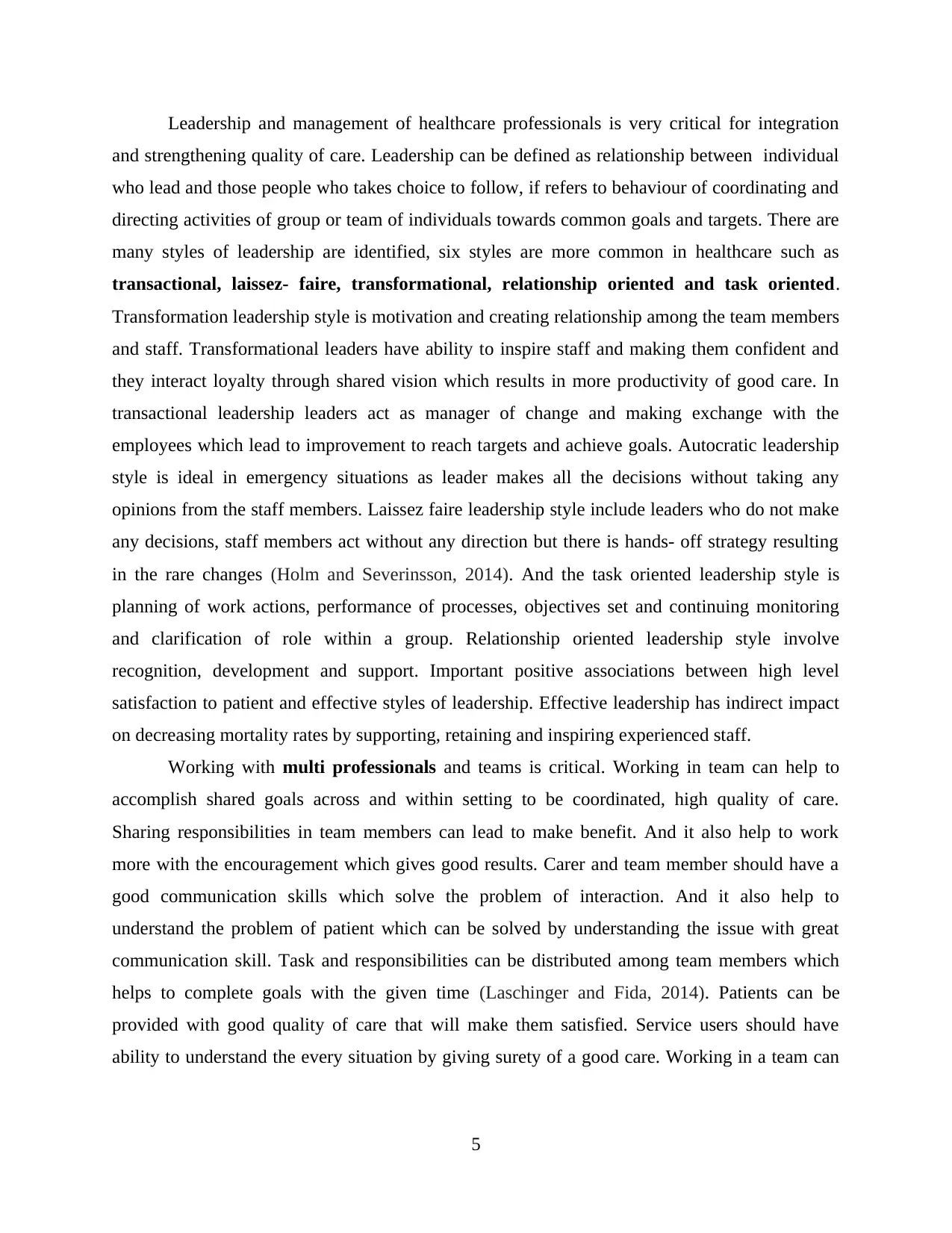
Leadership and management of healthcare professionals is very critical for integration
and strengthening quality of care. Leadership can be defined as relationship between individual
who lead and those people who takes choice to follow, if refers to behaviour of coordinating and
directing activities of group or team of individuals towards common goals and targets. There are
many styles of leadership are identified, six styles are more common in healthcare such as
transactional, laissez- faire, transformational, relationship oriented and task oriented.
Transformation leadership style is motivation and creating relationship among the team members
and staff. Transformational leaders have ability to inspire staff and making them confident and
they interact loyalty through shared vision which results in more productivity of good care. In
transactional leadership leaders act as manager of change and making exchange with the
employees which lead to improvement to reach targets and achieve goals. Autocratic leadership
style is ideal in emergency situations as leader makes all the decisions without taking any
opinions from the staff members. Laissez faire leadership style include leaders who do not make
any decisions, staff members act without any direction but there is hands- off strategy resulting
in the rare changes (Holm and Severinsson, 2014). And the task oriented leadership style is
planning of work actions, performance of processes, objectives set and continuing monitoring
and clarification of role within a group. Relationship oriented leadership style involve
recognition, development and support. Important positive associations between high level
satisfaction to patient and effective styles of leadership. Effective leadership has indirect impact
on decreasing mortality rates by supporting, retaining and inspiring experienced staff.
Working with multi professionals and teams is critical. Working in team can help to
accomplish shared goals across and within setting to be coordinated, high quality of care.
Sharing responsibilities in team members can lead to make benefit. And it also help to work
more with the encouragement which gives good results. Carer and team member should have a
good communication skills which solve the problem of interaction. And it also help to
understand the problem of patient which can be solved by understanding the issue with great
communication skill. Task and responsibilities can be distributed among team members which
helps to complete goals with the given time (Laschinger and Fida, 2014). Patients can be
provided with good quality of care that will make them satisfied. Service users should have
ability to understand the every situation by giving surety of a good care. Working in a team can
5
and strengthening quality of care. Leadership can be defined as relationship between individual
who lead and those people who takes choice to follow, if refers to behaviour of coordinating and
directing activities of group or team of individuals towards common goals and targets. There are
many styles of leadership are identified, six styles are more common in healthcare such as
transactional, laissez- faire, transformational, relationship oriented and task oriented.
Transformation leadership style is motivation and creating relationship among the team members
and staff. Transformational leaders have ability to inspire staff and making them confident and
they interact loyalty through shared vision which results in more productivity of good care. In
transactional leadership leaders act as manager of change and making exchange with the
employees which lead to improvement to reach targets and achieve goals. Autocratic leadership
style is ideal in emergency situations as leader makes all the decisions without taking any
opinions from the staff members. Laissez faire leadership style include leaders who do not make
any decisions, staff members act without any direction but there is hands- off strategy resulting
in the rare changes (Holm and Severinsson, 2014). And the task oriented leadership style is
planning of work actions, performance of processes, objectives set and continuing monitoring
and clarification of role within a group. Relationship oriented leadership style involve
recognition, development and support. Important positive associations between high level
satisfaction to patient and effective styles of leadership. Effective leadership has indirect impact
on decreasing mortality rates by supporting, retaining and inspiring experienced staff.
Working with multi professionals and teams is critical. Working in team can help to
accomplish shared goals across and within setting to be coordinated, high quality of care.
Sharing responsibilities in team members can lead to make benefit. And it also help to work
more with the encouragement which gives good results. Carer and team member should have a
good communication skills which solve the problem of interaction. And it also help to
understand the problem of patient which can be solved by understanding the issue with great
communication skill. Task and responsibilities can be distributed among team members which
helps to complete goals with the given time (Laschinger and Fida, 2014). Patients can be
provided with good quality of care that will make them satisfied. Service users should have
ability to understand the every situation by giving surety of a good care. Working in a team can
5
Paraphrase This Document
Need a fresh take? Get an instant paraphrase of this document with our AI Paraphraser
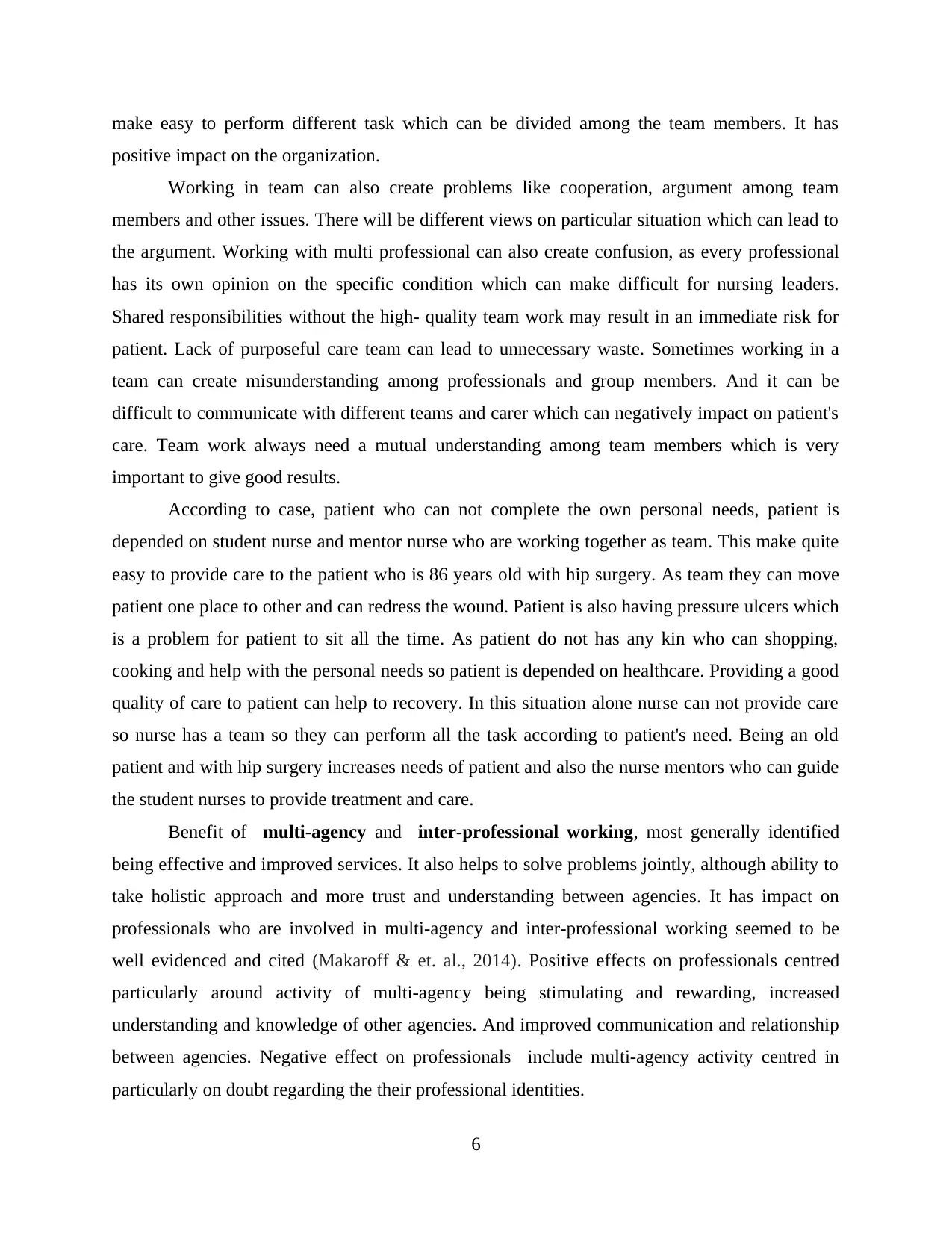
make easy to perform different task which can be divided among the team members. It has
positive impact on the organization.
Working in team can also create problems like cooperation, argument among team
members and other issues. There will be different views on particular situation which can lead to
the argument. Working with multi professional can also create confusion, as every professional
has its own opinion on the specific condition which can make difficult for nursing leaders.
Shared responsibilities without the high- quality team work may result in an immediate risk for
patient. Lack of purposeful care team can lead to unnecessary waste. Sometimes working in a
team can create misunderstanding among professionals and group members. And it can be
difficult to communicate with different teams and carer which can negatively impact on patient's
care. Team work always need a mutual understanding among team members which is very
important to give good results.
According to case, patient who can not complete the own personal needs, patient is
depended on student nurse and mentor nurse who are working together as team. This make quite
easy to provide care to the patient who is 86 years old with hip surgery. As team they can move
patient one place to other and can redress the wound. Patient is also having pressure ulcers which
is a problem for patient to sit all the time. As patient do not has any kin who can shopping,
cooking and help with the personal needs so patient is depended on healthcare. Providing a good
quality of care to patient can help to recovery. In this situation alone nurse can not provide care
so nurse has a team so they can perform all the task according to patient's need. Being an old
patient and with hip surgery increases needs of patient and also the nurse mentors who can guide
the student nurses to provide treatment and care.
Benefit of multi-agency and inter-professional working, most generally identified
being effective and improved services. It also helps to solve problems jointly, although ability to
take holistic approach and more trust and understanding between agencies. It has impact on
professionals who are involved in multi-agency and inter-professional working seemed to be
well evidenced and cited (Makaroff & et. al., 2014). Positive effects on professionals centred
particularly around activity of multi-agency being stimulating and rewarding, increased
understanding and knowledge of other agencies. And improved communication and relationship
between agencies. Negative effect on professionals include multi-agency activity centred in
particularly on doubt regarding the their professional identities.
6
positive impact on the organization.
Working in team can also create problems like cooperation, argument among team
members and other issues. There will be different views on particular situation which can lead to
the argument. Working with multi professional can also create confusion, as every professional
has its own opinion on the specific condition which can make difficult for nursing leaders.
Shared responsibilities without the high- quality team work may result in an immediate risk for
patient. Lack of purposeful care team can lead to unnecessary waste. Sometimes working in a
team can create misunderstanding among professionals and group members. And it can be
difficult to communicate with different teams and carer which can negatively impact on patient's
care. Team work always need a mutual understanding among team members which is very
important to give good results.
According to case, patient who can not complete the own personal needs, patient is
depended on student nurse and mentor nurse who are working together as team. This make quite
easy to provide care to the patient who is 86 years old with hip surgery. As team they can move
patient one place to other and can redress the wound. Patient is also having pressure ulcers which
is a problem for patient to sit all the time. As patient do not has any kin who can shopping,
cooking and help with the personal needs so patient is depended on healthcare. Providing a good
quality of care to patient can help to recovery. In this situation alone nurse can not provide care
so nurse has a team so they can perform all the task according to patient's need. Being an old
patient and with hip surgery increases needs of patient and also the nurse mentors who can guide
the student nurses to provide treatment and care.
Benefit of multi-agency and inter-professional working, most generally identified
being effective and improved services. It also helps to solve problems jointly, although ability to
take holistic approach and more trust and understanding between agencies. It has impact on
professionals who are involved in multi-agency and inter-professional working seemed to be
well evidenced and cited (Makaroff & et. al., 2014). Positive effects on professionals centred
particularly around activity of multi-agency being stimulating and rewarding, increased
understanding and knowledge of other agencies. And improved communication and relationship
between agencies. Negative effect on professionals include multi-agency activity centred in
particularly on doubt regarding the their professional identities.
6
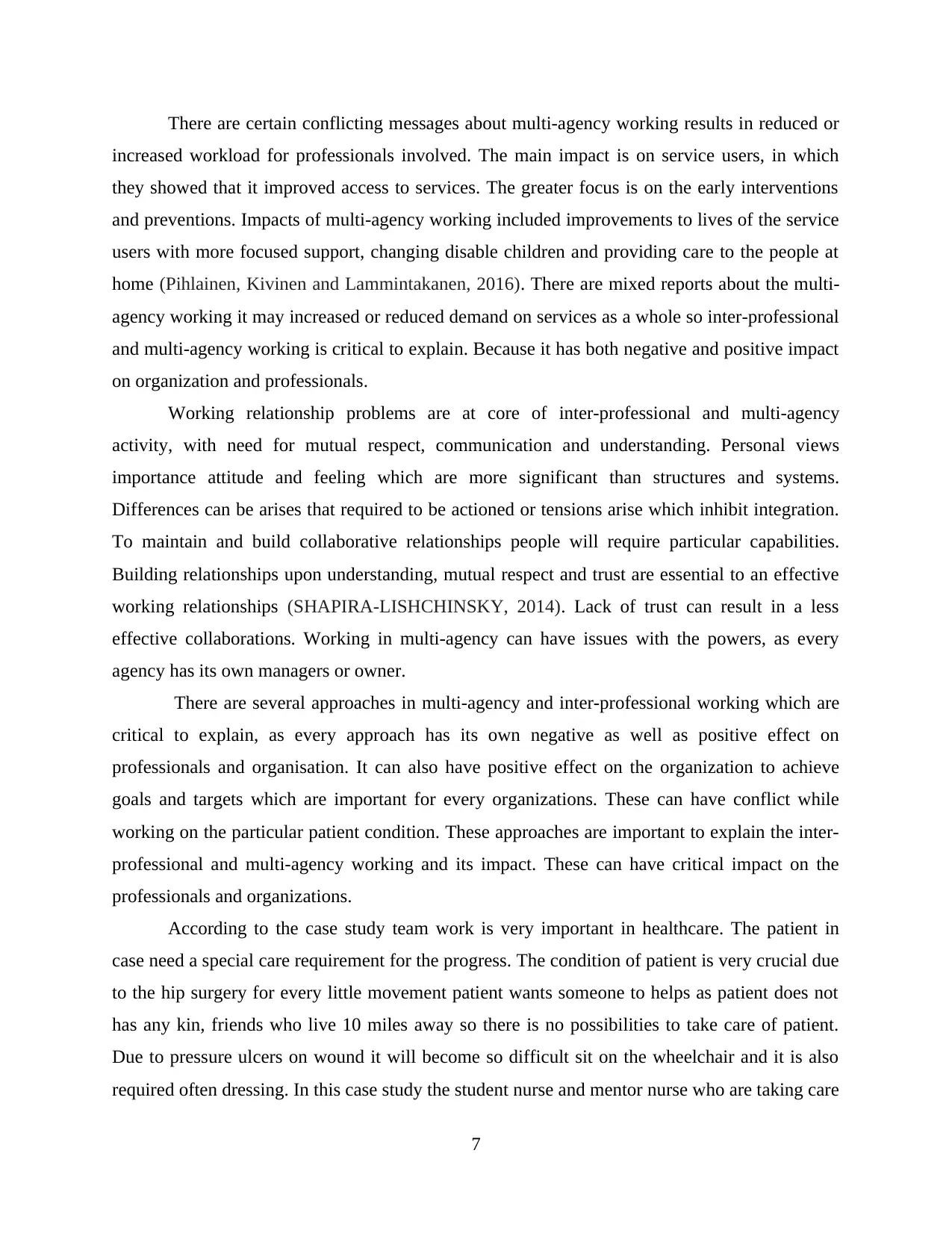
There are certain conflicting messages about multi-agency working results in reduced or
increased workload for professionals involved. The main impact is on service users, in which
they showed that it improved access to services. The greater focus is on the early interventions
and preventions. Impacts of multi-agency working included improvements to lives of the service
users with more focused support, changing disable children and providing care to the people at
home (Pihlainen, Kivinen and Lammintakanen, 2016). There are mixed reports about the multi-
agency working it may increased or reduced demand on services as a whole so inter-professional
and multi-agency working is critical to explain. Because it has both negative and positive impact
on organization and professionals.
Working relationship problems are at core of inter-professional and multi-agency
activity, with need for mutual respect, communication and understanding. Personal views
importance attitude and feeling which are more significant than structures and systems.
Differences can be arises that required to be actioned or tensions arise which inhibit integration.
To maintain and build collaborative relationships people will require particular capabilities.
Building relationships upon understanding, mutual respect and trust are essential to an effective
working relationships (SHAPIRA‐LISHCHINSKY, 2014). Lack of trust can result in a less
effective collaborations. Working in multi-agency can have issues with the powers, as every
agency has its own managers or owner.
There are several approaches in multi-agency and inter-professional working which are
critical to explain, as every approach has its own negative as well as positive effect on
professionals and organisation. It can also have positive effect on the organization to achieve
goals and targets which are important for every organizations. These can have conflict while
working on the particular patient condition. These approaches are important to explain the inter-
professional and multi-agency working and its impact. These can have critical impact on the
professionals and organizations.
According to the case study team work is very important in healthcare. The patient in
case need a special care requirement for the progress. The condition of patient is very crucial due
to the hip surgery for every little movement patient wants someone to helps as patient does not
has any kin, friends who live 10 miles away so there is no possibilities to take care of patient.
Due to pressure ulcers on wound it will become so difficult sit on the wheelchair and it is also
required often dressing. In this case study the student nurse and mentor nurse who are taking care
7
increased workload for professionals involved. The main impact is on service users, in which
they showed that it improved access to services. The greater focus is on the early interventions
and preventions. Impacts of multi-agency working included improvements to lives of the service
users with more focused support, changing disable children and providing care to the people at
home (Pihlainen, Kivinen and Lammintakanen, 2016). There are mixed reports about the multi-
agency working it may increased or reduced demand on services as a whole so inter-professional
and multi-agency working is critical to explain. Because it has both negative and positive impact
on organization and professionals.
Working relationship problems are at core of inter-professional and multi-agency
activity, with need for mutual respect, communication and understanding. Personal views
importance attitude and feeling which are more significant than structures and systems.
Differences can be arises that required to be actioned or tensions arise which inhibit integration.
To maintain and build collaborative relationships people will require particular capabilities.
Building relationships upon understanding, mutual respect and trust are essential to an effective
working relationships (SHAPIRA‐LISHCHINSKY, 2014). Lack of trust can result in a less
effective collaborations. Working in multi-agency can have issues with the powers, as every
agency has its own managers or owner.
There are several approaches in multi-agency and inter-professional working which are
critical to explain, as every approach has its own negative as well as positive effect on
professionals and organisation. It can also have positive effect on the organization to achieve
goals and targets which are important for every organizations. These can have conflict while
working on the particular patient condition. These approaches are important to explain the inter-
professional and multi-agency working and its impact. These can have critical impact on the
professionals and organizations.
According to the case study team work is very important in healthcare. The patient in
case need a special care requirement for the progress. The condition of patient is very crucial due
to the hip surgery for every little movement patient wants someone to helps as patient does not
has any kin, friends who live 10 miles away so there is no possibilities to take care of patient.
Due to pressure ulcers on wound it will become so difficult sit on the wheelchair and it is also
required often dressing. In this case study the student nurse and mentor nurse who are taking care
7
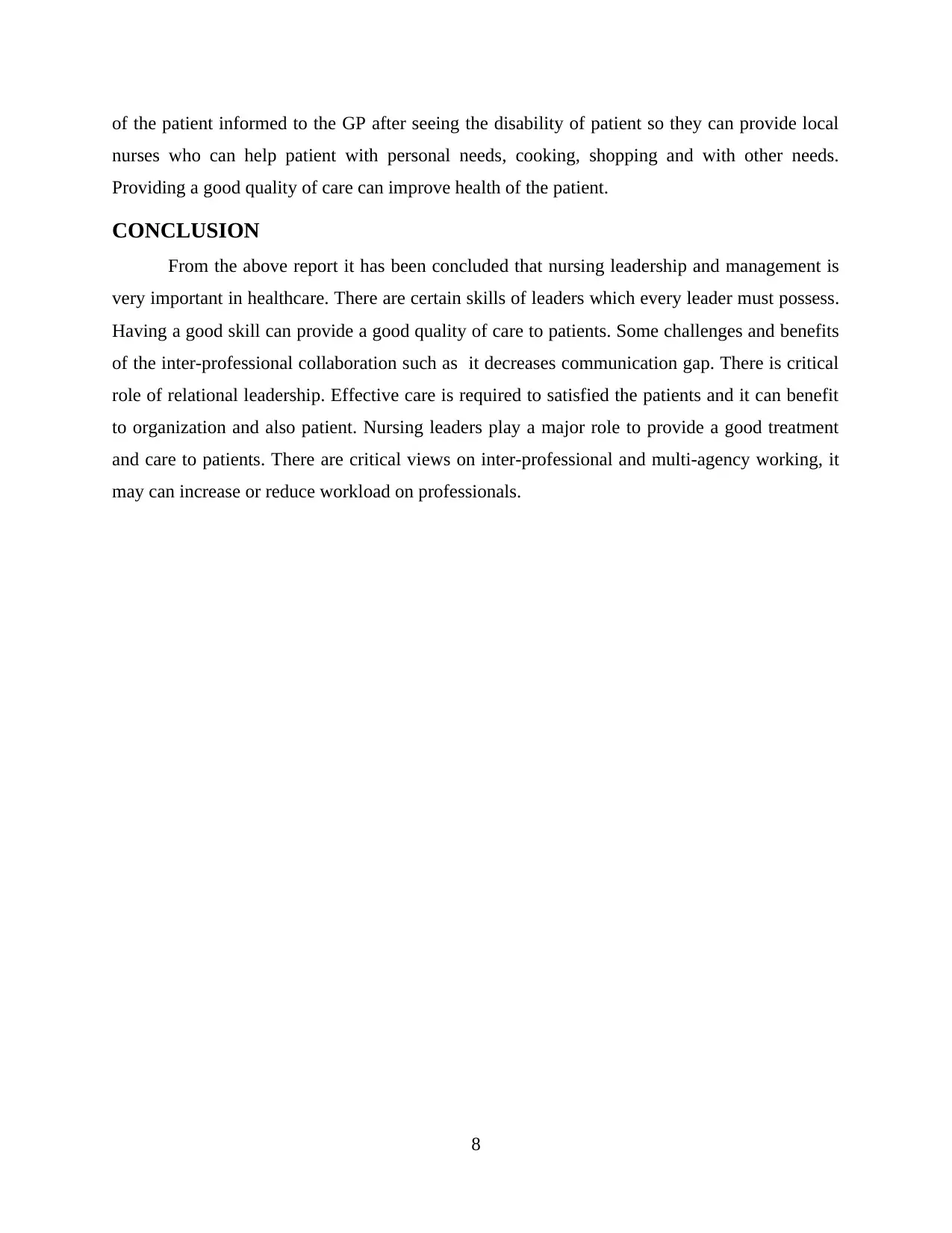
of the patient informed to the GP after seeing the disability of patient so they can provide local
nurses who can help patient with personal needs, cooking, shopping and with other needs.
Providing a good quality of care can improve health of the patient.
CONCLUSION
From the above report it has been concluded that nursing leadership and management is
very important in healthcare. There are certain skills of leaders which every leader must possess.
Having a good skill can provide a good quality of care to patients. Some challenges and benefits
of the inter-professional collaboration such as it decreases communication gap. There is critical
role of relational leadership. Effective care is required to satisfied the patients and it can benefit
to organization and also patient. Nursing leaders play a major role to provide a good treatment
and care to patients. There are critical views on inter-professional and multi-agency working, it
may can increase or reduce workload on professionals.
8
nurses who can help patient with personal needs, cooking, shopping and with other needs.
Providing a good quality of care can improve health of the patient.
CONCLUSION
From the above report it has been concluded that nursing leadership and management is
very important in healthcare. There are certain skills of leaders which every leader must possess.
Having a good skill can provide a good quality of care to patients. Some challenges and benefits
of the inter-professional collaboration such as it decreases communication gap. There is critical
role of relational leadership. Effective care is required to satisfied the patients and it can benefit
to organization and also patient. Nursing leaders play a major role to provide a good treatment
and care to patients. There are critical views on inter-professional and multi-agency working, it
may can increase or reduce workload on professionals.
8
Secure Best Marks with AI Grader
Need help grading? Try our AI Grader for instant feedback on your assignments.
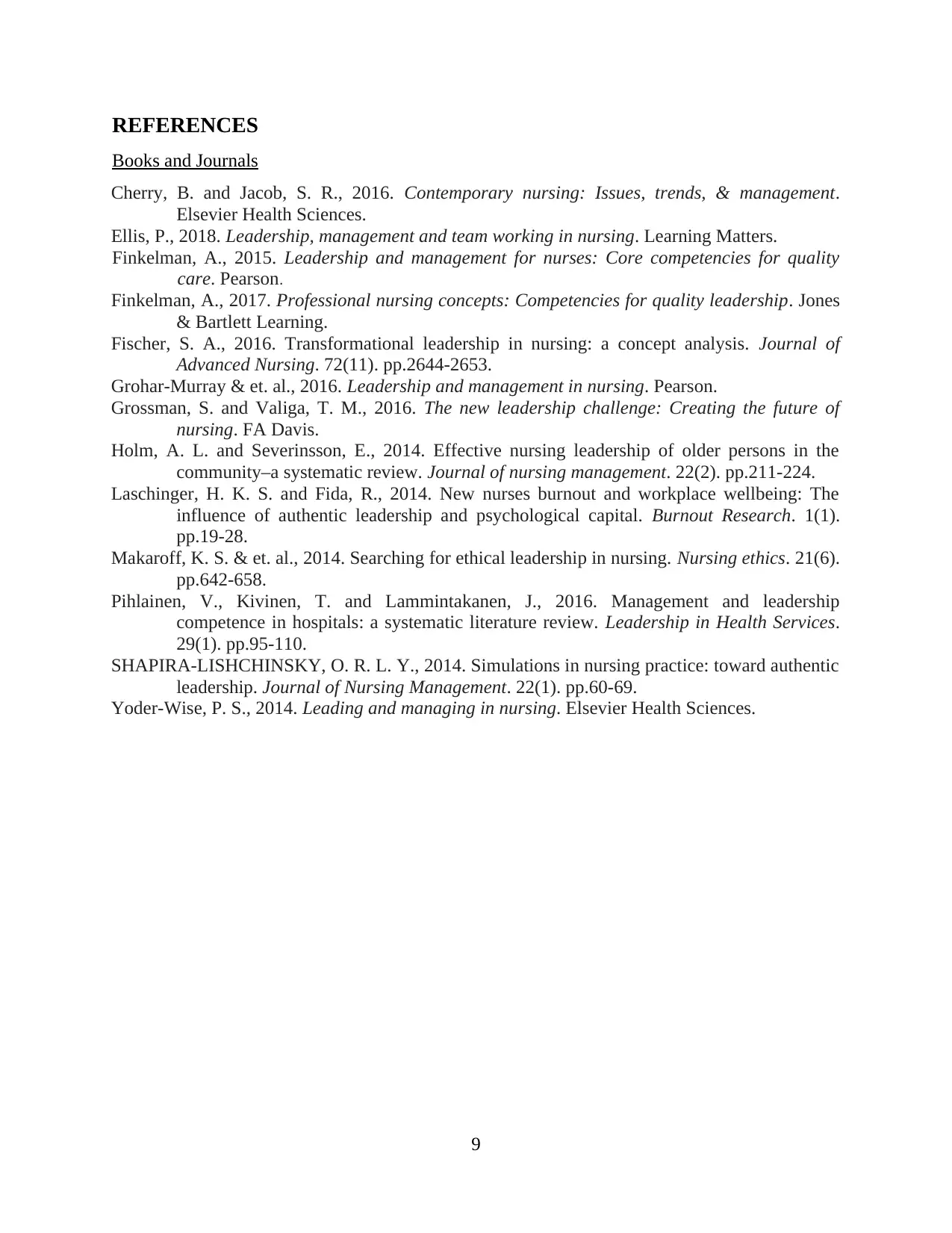
REFERENCES
Books and Journals
Cherry, B. and Jacob, S. R., 2016. Contemporary nursing: Issues, trends, & management.
Elsevier Health Sciences.
Ellis, P., 2018. Leadership, management and team working in nursing. Learning Matters.
Finkelman, A., 2015. Leadership and management for nurses: Core competencies for quality
care. Pearson.
Finkelman, A., 2017. Professional nursing concepts: Competencies for quality leadership. Jones
& Bartlett Learning.
Fischer, S. A., 2016. Transformational leadership in nursing: a concept analysis. Journal of
Advanced Nursing. 72(11). pp.2644-2653.
Grohar-Murray & et. al., 2016. Leadership and management in nursing. Pearson.
Grossman, S. and Valiga, T. M., 2016. The new leadership challenge: Creating the future of
nursing. FA Davis.
Holm, A. L. and Severinsson, E., 2014. Effective nursing leadership of older persons in the
community–a systematic review. Journal of nursing management. 22(2). pp.211-224.
Laschinger, H. K. S. and Fida, R., 2014. New nurses burnout and workplace wellbeing: The
influence of authentic leadership and psychological capital. Burnout Research. 1(1).
pp.19-28.
Makaroff, K. S. & et. al., 2014. Searching for ethical leadership in nursing. Nursing ethics. 21(6).
pp.642-658.
Pihlainen, V., Kivinen, T. and Lammintakanen, J., 2016. Management and leadership
competence in hospitals: a systematic literature review. Leadership in Health Services.
29(1). pp.95-110.
SHAPIRA‐LISHCHINSKY, O. R. L. Y., 2014. Simulations in nursing practice: toward authentic
leadership. Journal of Nursing Management. 22(1). pp.60-69.
Yoder-Wise, P. S., 2014. Leading and managing in nursing. Elsevier Health Sciences.
9
Books and Journals
Cherry, B. and Jacob, S. R., 2016. Contemporary nursing: Issues, trends, & management.
Elsevier Health Sciences.
Ellis, P., 2018. Leadership, management and team working in nursing. Learning Matters.
Finkelman, A., 2015. Leadership and management for nurses: Core competencies for quality
care. Pearson.
Finkelman, A., 2017. Professional nursing concepts: Competencies for quality leadership. Jones
& Bartlett Learning.
Fischer, S. A., 2016. Transformational leadership in nursing: a concept analysis. Journal of
Advanced Nursing. 72(11). pp.2644-2653.
Grohar-Murray & et. al., 2016. Leadership and management in nursing. Pearson.
Grossman, S. and Valiga, T. M., 2016. The new leadership challenge: Creating the future of
nursing. FA Davis.
Holm, A. L. and Severinsson, E., 2014. Effective nursing leadership of older persons in the
community–a systematic review. Journal of nursing management. 22(2). pp.211-224.
Laschinger, H. K. S. and Fida, R., 2014. New nurses burnout and workplace wellbeing: The
influence of authentic leadership and psychological capital. Burnout Research. 1(1).
pp.19-28.
Makaroff, K. S. & et. al., 2014. Searching for ethical leadership in nursing. Nursing ethics. 21(6).
pp.642-658.
Pihlainen, V., Kivinen, T. and Lammintakanen, J., 2016. Management and leadership
competence in hospitals: a systematic literature review. Leadership in Health Services.
29(1). pp.95-110.
SHAPIRA‐LISHCHINSKY, O. R. L. Y., 2014. Simulations in nursing practice: toward authentic
leadership. Journal of Nursing Management. 22(1). pp.60-69.
Yoder-Wise, P. S., 2014. Leading and managing in nursing. Elsevier Health Sciences.
9
1 out of 11
Related Documents
Your All-in-One AI-Powered Toolkit for Academic Success.
+13062052269
info@desklib.com
Available 24*7 on WhatsApp / Email
![[object Object]](/_next/static/media/star-bottom.7253800d.svg)
Unlock your academic potential
© 2024 | Zucol Services PVT LTD | All rights reserved.





